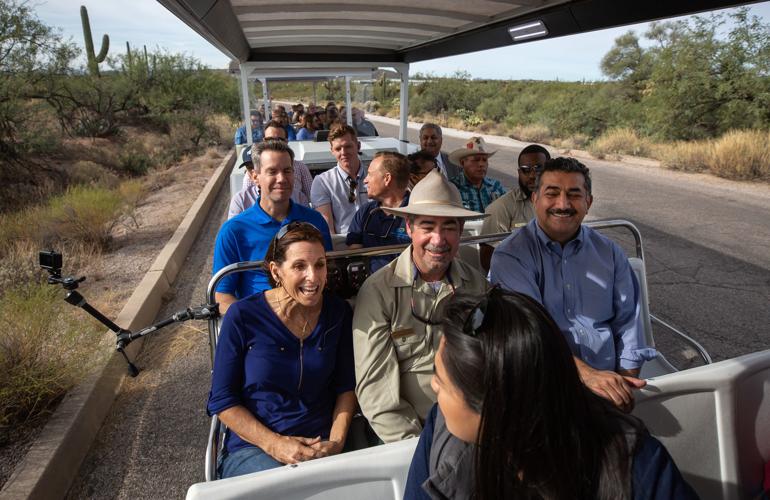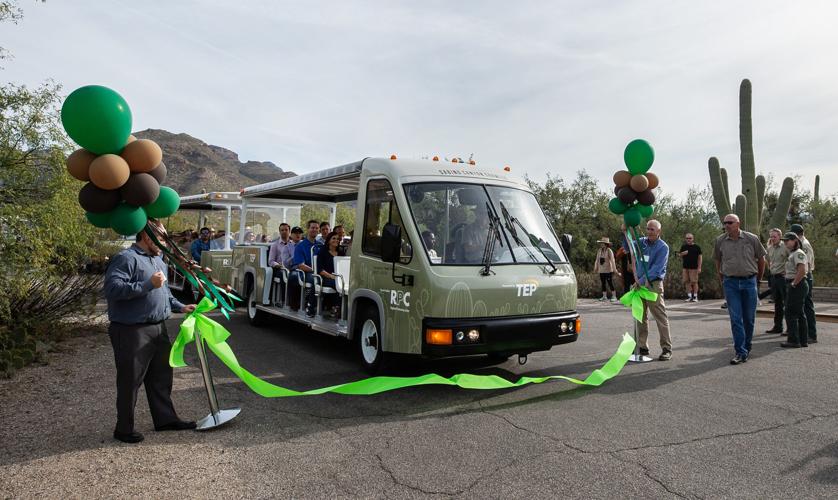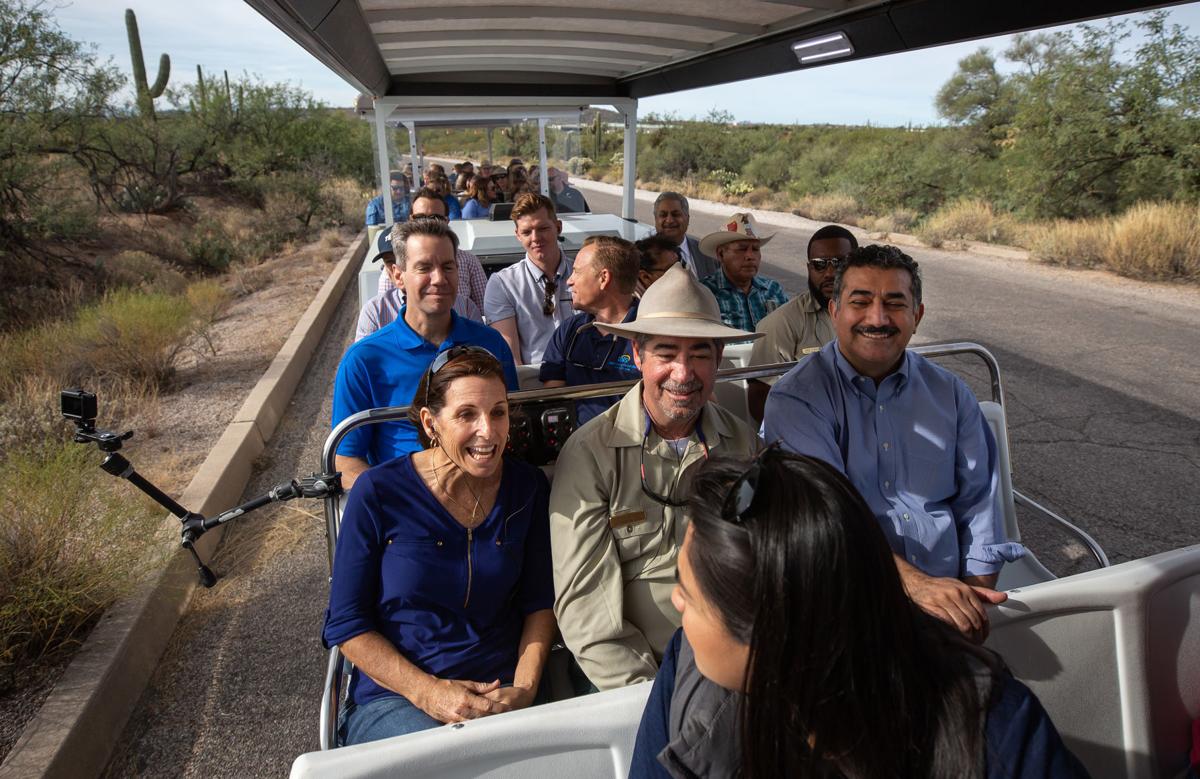Two years ago, having electric shuttle service in Sabino Canyon seemed like a faint dream for Paul Marques, then-president of Friends of Sabino Canyon. That dream became a reality Saturday, with a soft launch of the emission-free shuttle service.
The Regional Partnering Center, owners of the new shuttle service, introduced two shuttles to partners and visitors during a ceremony at the Sabino Canyon Visitor Center Saturday morning. The shuttles were custom-built for Sabino Canyon, Marques said.
Tucson Electric Power donated $1.5 million and provided a $1 million interest-free loan to fund the RPC’s purchase of the five shuttles, which cost $500,000 each. TEP also built the electric infrastructure for the charging stations for the shuttles.
David Hutchens, TEP president and CEO, said the shuttle service is just one of many projects the company is working on to reduce greenhouse gas emissions.
“Our community has been and is asking us to do our part in finding a global solution to climate change,” Hutchens said. “And I can tell you by what you’ve seen today, what we’re doing here with the shuttles, and what I just talked about from a renewable energy standpoint, you can look me in the eye, we’re doing our part.”
After reviewing feedback visitors submitted in 2017 to the U.S. Forest Service, members of Friends of Sabino Canyon worked with then-Rep. Martha McSally to allow competitive bidding for a new shuttle service, Marques said.
The 30-year-old diesel vehicle service was noisy, smelly and outdated, he said. Based on public comments, the majority of visitors agreed, Marques said.
“If you have ever walked on a cloudy day where there’s overcast, the smell of those old shuttles would follow you for miles through the canyon because there was nowhere for the fumes to escape to,” he said.
McSally, now a U.S. senator, who said she would run the 7.4-mile trail in the canyon to train for marathons, echoed that statement, saying Sabino Canyon needed to modernize its shuttle service to meet the needs of tourists.
Satish Hiremath, chairman of the RPC, honored the Native American tribes — including the Tohono O’Odham and Pascua Yaqui — that called Sabino Canyon home long before visitors hiked the canyon.
“This sacred land continues to be important for the ongoing health, livelihood and economic vitality of our residents and visitors,” he said.
He said the electric shuttles will help preserve the canyon for future generations by eliminating the use of 15,000 gallons of gasoline each month, reducing carbon monoxide emissions by 400,000 pounds annually once the service is fully operational.
Since early September, nine Sabino Canyon Shuttle drivers have been testing the 62-passenger shuttles, starting in parking lots before training along the Sabino and Bear Canyon tour routes, roughly 6 miles of travel.

David Hutchens, TEP president and CEO, said the new shuttle service for Sabino Canyon is just one of many projects the company is working on to reduce greenhouse gas emissions.
The new shuttles will initially only serve the Sabino Canyon route, while the smaller, gasoline shuttles will continue the much shorter Bear Canyon route, Marques said.
The fleet of five open-air shuttles will provide service to about 100,000 annual riders, according to a Coronado National Forest news release.
These changes will benefit everyone, said Roger Bissonnette, operations manager of Sabino Canyon Shuttle.
“I’m excited to give just a high-quality tour and a pleasant, clean, and quiet ride not only for the passengers but also for the hikers,” Bissonnette said. “A lot of people like to hike in the canyon and they’re not going to miss the smell of the diesel vehicles.”
The first shuttle was delivered for testing from Trams International, a California-based manufacturer, on Sept. 3.
“My drivers for the last month have been testing in the canyon, up and down, and things are going very well,” Bissonnette said.
Bissonnette also said Trams International staff were wrapping up testing of the new educational system on board for visitors.
“It’s a GPS triggered audio tour,” said Bissonnette. “This system is actually a lot quieter, it’s not going to be blasted through speakers. It’ll be through headphones at each seat.”
At launch, an English and Spanish audio version of the tour is available. More languages will be added later, Bissonnette said.
The audio tour teaches visitors about the plants and wildlife in the area, and their role in maintaining the canyon’s ecosystem. It also tells visitors about seasonal changes they may see in the plants and where to find specific types of wildlife.
At each stop, the audio tour will let visitors know whether there is access to restrooms and water.
The shuttles also have fully integrated ticket sales, including cellphone payments and credit- and debit-card sales for visitors, giving them options for getting off and on the shuttles, forest officials said. The previous shuttle vendor operated on a cash-only basis.
“We like to think it’s a lot safer with this process, and this is why we went this route, because the drivers can focus on safety and quality of driving and the tour,” Bissonnette said.
Photos: Sabino Canyon through the years

Men on horseback in Sabino Canyon north of Tucson, ca. 1950s.

A camping trip in Sabino Canyon by a company of Military students from the UA and Capt. Maxon in December 1903.

Sabino Canyon in 1904.

Sabino Canyon, March 25, 1911.

Sabino Canyon in 1912.

Fishing for trout in Lower Sabino Canyon in May, 1951.

Sabino Creek at Sabino Canyon Recreation Area north of Tucson, probably ca. 1950s.

A dry Sabino Creek at Sabino Canyon Recreation Area north of Tucson, probably ca. 1950s.

Undated photo of snow at Sabino Canyon Recreation Area north of Tucson. Probably ca. 1950s.

Undated photo of snow at Sabino Canyon Recreation Area north of Tucson. Probably ca. 1950s.

Fishing in Sabino Creek at Sabino Canyon Recreation Area north of Tucson. Probably ca. 1950s.

Cookout at Sabino Canyon Recreation Area north of Tucson, ca. 1950s.

Undated photo of Sabino Canyon, probably 1950s. at Sabino Canyon Recreation Area north of Tucson.

Construction crews work to deepen the lake in Sabino Canyon north of Tucson in March, 1951.

A boy fishes in the lake at Sabino Canyon north of Tucson in May, 1951, after it was stocked with trout for the first time.

People fish in the lake at Sabino Canyon north of Tucson in May 1951, after it was stocked with trout for the first time. Photo credit: Arizona Daily Star

Water gushes over the entire 90-foot width of the Lower Sabino Dam at Sabino Canyon Recreation Area north of Tucson in March, 1954, after a steady two-day rain. It was the heaviest flow over the dam since 1932.

Sabino Creek at Sabino Canyon Recreation Area north of Tucson in March, 1956.

A U.S. Geological Survey employee checks water level several hundred yards upstream from Lower Sabino Dam in 1956 at Sabino Canyon Recreation Area north of Tucson.

Sabino Canyon on Nov. 4, 1963.

The yet-unfinished Sabino Canyon gatehouse, about a half mile away from the Visitor Center, was several days away from completion on September 2, 1969. The roadway throughout the area was repaved causing some temporary closing of certain recreation sites.

Civilian Conservation Corps workers make adobe bricks in lower Sabino Canyon.

Heavy rains produced a sizeable flow through Sabino Canyon on Dec. 29, 1972. Forty-four people were evacuated from the canyon area and search teams rescued a 15-year-old from floodwaters. Photo by Bruce Hopkins / Tucson Citizen

Undated photo of rocks in Sabino Creek at Sabino Canyon Recreation Area north of Tucson.

Filming the television series "Gunsmoke" in Lower Sabino Canyon. April 23, 1973.
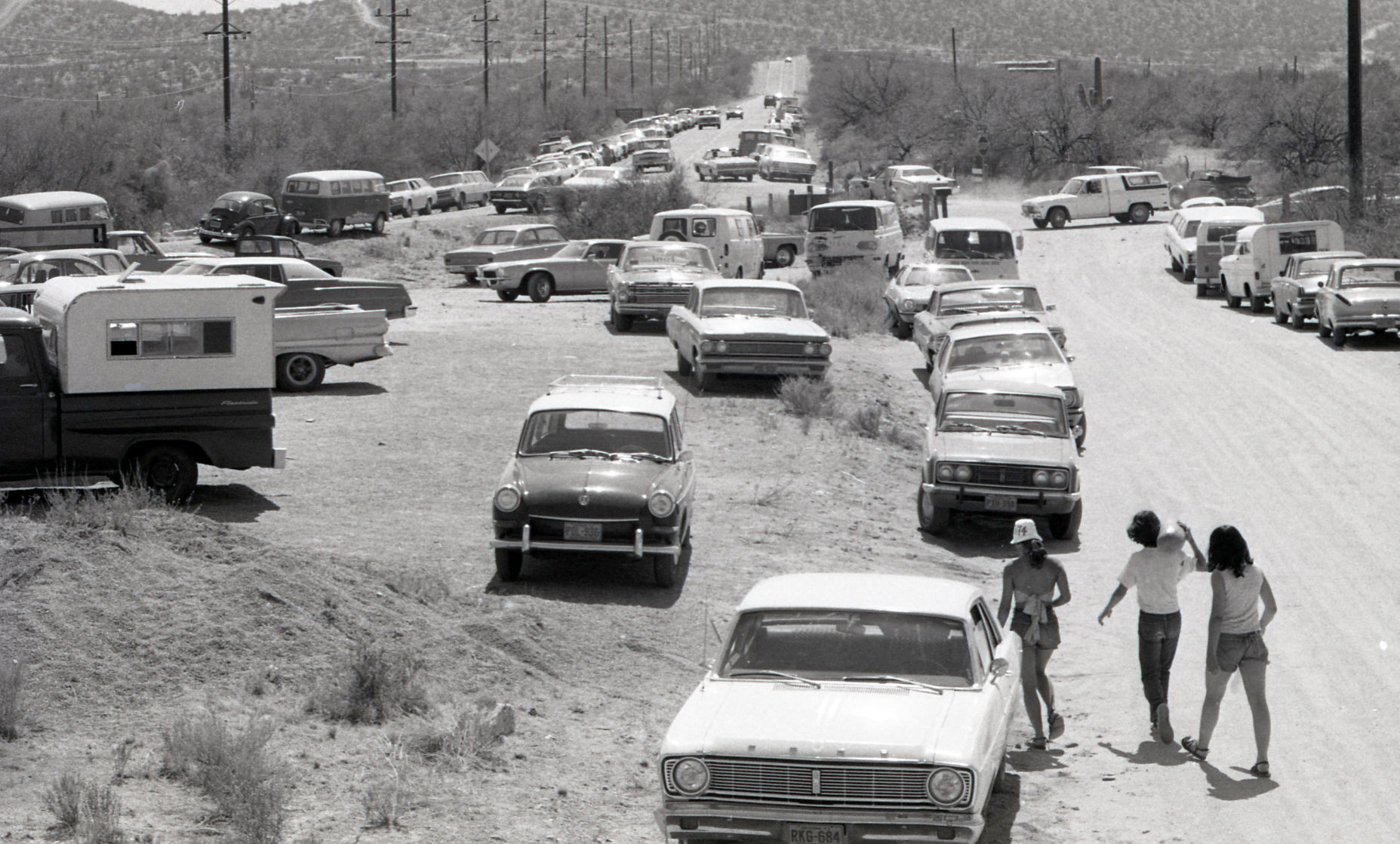
Hundreds of cars parked haphazardly along Sabino Canyon Road outside Sabino Canyon National Recreation Area north of Tucson in March, 1974, before the parking lot was expanded and vehicles were banned from the canyon.

Cars parked haphazardly along Sabino Canyon Road outside Sabino Canyon National Recreation Area north of Tucson in March, 1974, before the parking lot was expanded and vehicles were banned from the canyon.

People jump into Sabino Creek at the Sabino Canyon National Recreation Area north of Tucson in September, 1981.

A shuttle bus ferries passengers into Sabino Canyon National Recreation Area north of Tucson in June, 1978. The service was offered only in Upper Sabino until more trams were delivered. Vehicles were banned permanently in 1981.

Sabino Canyon National Recreation Area north of Tucson in September, 1981.

A tram loaded with passengers crosses Sabino Creek in Sabino Canyon National Recreation Area north of Tucson in September, 1981.

People play volleyball in the "lake" behind the dam on Sabino Creek at Sabino Canyon National Recreation Area north of Tucson in September, 1981.

Maria Reyna, left, and friend Gena Vidal cool off in a pool at Sabino Canyon National Recreation Area north of Tucson during record heat on June, 26, 1990.

Maria Reyna, left, and friend Gena Vidal have a water fight in a pool at Sabino Canyon National Recreation Area north of Tucson during record heat on June, 26, 1990.

Neil Meicke enjoys his day off as an electrician to take advantage of some cool water at Sabino Canyon north of stop #8 just about a 1/4 mile from the top of the Canyon. Meicke was there with his wife Terrie Meicke and daughter Caitlin, age 5. Photo taken in May, 1997.

Water and winter visitors roll through Sabino Canyon...One day after rains drenched Tucson, the weather was good enough to lure tramloads of visitors yesterday to Sabino Canyon, where water deposited by recent storms ran freely in Feb., 1998.

Early evening walkers climb the hill leading out of Sabino Canyon as the summer sky turns to night in July, 1998.

Jason Poore of Louisville, Kentucky, jumps from a rockface in an area known as the "crack" a popular water hole in Sabino Canyon between stops #8 and #9, in Aug. 2000.

U.S. Forest Service crews clear debris and destroyed chunks of roadway from the road above the second creek crossing in Sabino Canyon in July, 1999.

Stephanie Garmon and Ray Lilly make their way over a Sabino Canyon bridge after a torrential rain in July, 1999.

Bob Keeler and his 11-year-old son John enjoy cool water from recent storms flowing over the lower Sabino Canyon dam in July, 1999.

Todd Craven and his brother Scott Craven remove a log from the lower Sabino Canyon area in July, 1999. Volunteers helped clean up the debris that was scattered all over Sabino Canyon after heavy rain.

Out for a cool walk in the park. That is just what these folks are doing as they are getting their exercise in by walking in and out of the Sabino Canyon area in August, 2000.

Pleasant Valley Hotshots make their way toward a waiting helicopter to take them to Rattlesnake Ridge to fight a lightning-caused fire in June, 2000.

A saguaro is sillouetted as the Rattlesnake Ridge fire rages down the southern side of the Santa Catalina Mountains near Sabino Canyon on June 7, 2000.

Rogan Cudworth plays in the water at Sabino Canyon's "The Crack" area, a popular area because of running water and sand-like beaches, in March, 2000.

Sabino Canyon Visitors walk up the road as the vivid color of the sunset glows in the background February 24, 2002.

This mountain lion, shown in May, 2004, which was captured near Sabino Canyon, might have died had she not been caught.

A tram carries passengers across a bridge as a high-flowing Sabino Creek tumbles by in Sabino Canyon on August 9, 2010.

Water from a high-flowing Sabino Creek rolls past a small tree in Sabino Canyon in Tucson, Ariz., August 9, 2010.

Mountain bikers take advantage of the beautiful scenery in the upper Sabino Canyon/Aspen Draw area in the Catalinas. Photo taken 9/26/10.

Reddish brown ferns show the start of autumn color in upper Sabino Canyon/Aspen Draw area in the Catalinas. Photo taken 9/26/10

Visitors walk and run into Sabino Canyon early in the morning on December 28, 2011, in Tucson, Ariz. The local residents usually arrive early to exercise for their wellness, said Larry Pratt, a recreation project manager with the US Forest Service.

Alison Matson gets come help from Alex Decker as they both cross the creek in Sabino Canyon on December 28, 2011, in Tucson, Ariz. Residents and winter visitors come to Sabino during the Holiday break to walk, run or bicycle for their general wellness, get close to nature, ride the shuttle or search for some peace and quiet.

An animated Dan Granger, a Sabino Canyon volunteer naturalist, holds a bobcat during a puppet show he performed in front of children and adults at the annual Music in the Canyon by the Friends of Sabino Canyon March 6, 2011.

Shuttle driver Janell Gardner works her way through a traffic jam down Sabino Canyon as she follows one shuttle and slides by another going up the canyon on Wednesday, December 28, 2011, in Tucson, Ariz. What Gardner likes most about driving through the canyon, is the canyon itself. Residents and winter visitors come to Sabino during the Holiday break to walk, run or bicycle for their general wellness, get close to nature, ride the shuttle or search for some peace and quiet.

Members of the group, the Desert Sons performed at the annual Music in the Canyon by the Friends of Sabino Canyon on March 6, 2011, in Tucson, Ariz. There was music, food, raffles, and activities for children at the event.

Dave Konigsberg and family make their way along the Blackett's Ridge Trail trail in Sabino Canyon on, November 8, 2011.

A full moon rises above a saguaro forest on the Blackett's Ridge Trail trail in Sabino Canyon on November 8, 2011.

Large boulders are seen near tram stop number 2 at Sabino Canyon on April 11, 2011 in Tucson, Ariz. Large boulders, like these near Tram Stop 2 in Sabino Canyon, likely tumbled from higher in the canyon at some unknown time in the past during a rock fall or landslide. Sometime in the distant future, they will be worn down to pebbles and sand and washed out of the canyon.

A rock flow seen at the end of the tram route at stop 9 at Sabino Canyon on April 11, 2011 in Tucson, Ariz. This dramatic debris flow, a result of a powerful 2006 flood in Sabino Canyon, is near Tram Stop 9 at the end of the canyon road. For an April 17 Vamos cover story, we plan to describe and show a sort of self-guided tour of geologic sites visible along the road in Sabino Canyon.
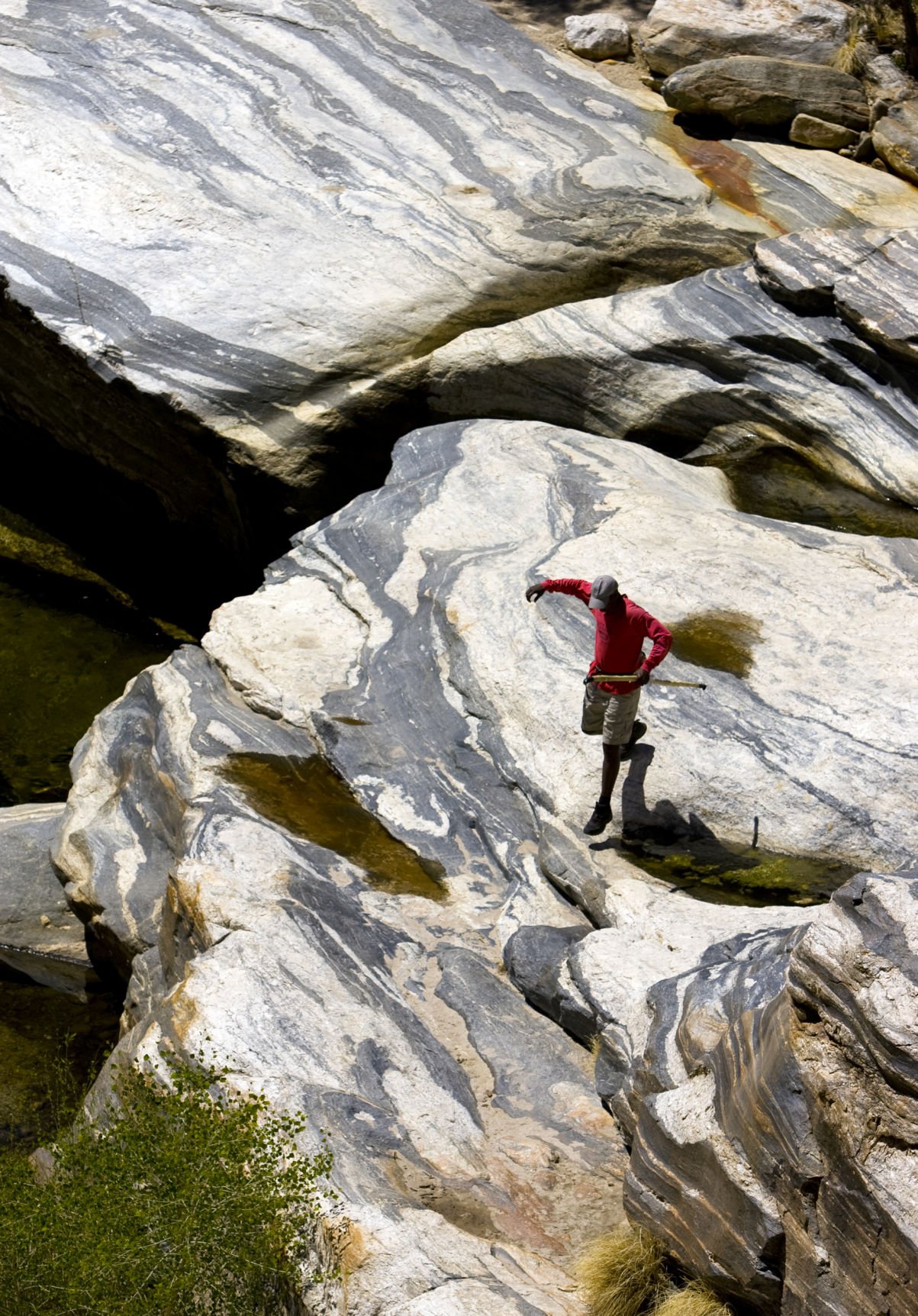
A hiker makes his way through rock formations near tram stop 8 at Sabino Canyon on April 11, 2011 in Tucson, Ariz. hiker navigates an expanse of gneiss rock near Tram Stop 8 in Sabino Canyon. It's a site where pockets and natural tanks in the rock sometimes hold water from rainfall or high stream flows.

Randy Strissel and Glenna Strissel of Marysville, Tennessee, walk among rocks where water would normally be flowing near tram stop #8 in Sabino Canyon on July 5, 2012.

A Coues White-tailed deer pauses right next to the road at Sabino Canyon. Whether it is on the road or along a trail, there are plenty of sights to please and entice the senses. The photo was taken in Tucson, Ariz., on Tuesday, Nov. 24, 2015.

A walker begins the long drop into Sabino Canyon which can be a good choice to as a means to work off those Thanksgiving dinner calories. Whether it is on the road or along a trail, there are plenty of sights to please and entice the senses. The photo was taken in Tucson, Ariz., on Tuesday, Nov. 24, 2015.

Saguaros are on a blooming binge in Sabino Canyon northeast of Tucson. Photo taken on May 13, 2016.

Korean middle school student Heidi Choi Hyun Hee, 13, documents her experience crossing a Sabino Creek in Jan., 2016, while taking a tram as she and fellow students explore the canyon. Students from Magee and Secrist Middle Schools and Safford K-8 Magnet School joined the Korean students as they took a tram up Sabino Canyon then stopped to have lunch then wander around the area.

Hikers trek a tree-shaded trail in the Upper Sabino Canyon area high in the Catalina Mountains north of Tucson on June 5, 2016.

Monsoon rains have brought vibrant green hues to the deserts of Sabino Canyon on September 8, 2016.

A group of women stand on a bridge as they watch one of their party walk into the creek at Sabino Canyon National Recreation Area in Tucson, on August 7, 2016.

Ron Gonzales walks over a water-covered bridge at Sabino Canyon National Recreation Area as he gives his wife Mary a piggyback ride in Tucson, on August 7, 2016.

Snow melt from Mt. Lemmon has made its way down into Sabino Canyon filling up Sabino creek with water on January 11, 2017.

Visitors admire the water in Sabino Creek at the first crossing aboard the Sabino Canyon Tours tram at Sabino Canyon, 5700 N. Sabino Canyon Road, on Aug. 31, 2017, in Tucson, Ariz.

Naomy Robles, 7, sits atop dad Raul’s shoulder while they bask in the water cascading over Sabino Dam as visitors to Sabino Canyon enjoy a cooling-off in the abundant monsoon runoff flow near the Sabino Dam in 2017.

With creek levels low, Mie Welsch, right, and 12-year-old daughter Jamie are able to traverse the route across Sabino Creek south of the dam as Autumn color still clings to the branches on trees dotting Sabino Creek at Sabino Canyon Recreation Area, 5900 N. Sabino Canyon Road, on Jan. 5, 2018, in Tucson, Ariz.

Autumn color still clings to the branches on trees dotting Sabino Creek at Sabino Canyon Recreation Area, 5900 N. Sabino Canyon Road, on Jan. 5, 2018, in Tucson, Ariz.

Young girls toe the slippery rocks at the Sabino Dam at Sabino Canyon Recreation Area, 5700 N. Sabino Canyon Road, on March 8, 2018, in Tucson, Ariz. The creek is finally flowing with winter runoff following more than 150 days of dry conditions.

Santa Catalina Volunteer Patrol volunteer Marty Horowitz, helps a group of visitors with trail information at Sabino Canyon Recreation Area, 5700 N. Sabino Canyon Road, Jan. 4, 2019, in Tucson, Ariz. Volunteers with the SCVP have helped Sabino Canyon visitors with trail information and general assistance amid the partial government shutdown.

A hiker reaches the rocky top of Blackett's Ridge in Sabino Canyon.

Hikers make their way along Sabino Creek as the first hints of autumn color appear in Sabino Canyon.

Rural Metro Fire firefighters send a life vest out on a line to a man stranded in Sabino Creek floodwaters in Sabino Canyon Recreation Area on Feb. 15, 2019, in Tucson, Ariz. The man had been stuck on the tree in the middle of a raging Sabino Creek for several hours after having been swept down from a tram crossing upstream.

Visitors to Sabino Canyon partake in the glorious desert Spring weather on April 2, 2019 in Tucson.

Visitors to Sabino Canyon board the new transitional shuttle for a ride to the top on April 2, 2019 in Tucson, AZ.

Visitors to Sabino Canyon partake of the glorious desert weather on April 2, 2019 in Tucson, AZ.

Visitors to Sabino Canyon partake of the glorious desert Spring weather on April 2, 2019 in Tucson, AZ.

Visitors to Sabino Canyon partake of the glorious desert Spring weather on April 2, 2019 in Tucson, AZ.

Coronado National Forest spokeswoman Heidi Schewel says the shuttles will have “headphones for the narrated educational program.” She also said a “program that’s already packaged” will replace drivers’ narration along the route.

Troy Edwards, a shuttle driver in training, left, and Gary Youngling, a volunteer with Santa Catalina Volunteer Patrol, take a ride on the new electric shuttles at Sabino Canyon Recreation Area. Four other open-air shuttles are being tested by a California-based company.

The new Sabino Canyon electric crawlers make their way down the canyon road during the launch of the shuttles at the park, on Nov. 9, 2019.

After reviewing feedback visitors submitted in 2017 to the U.S. Forest Service, members of Friends of Sabino Canyon worked with Sen. Martha McSally, left, then a representative, to allow competitive bidding for a new shuttle service.

David Hutchens, TEP president and CEO, said the new shuttle service for Sabino Canyon is just one of many projects the company is working on to reduce greenhouse gas emissions.

A group of saguaro cacti are surrounded by ocotillo and lush green scenery along the Bear Canyon trail with green lush scenery at Sabino Canyon Recreational Area, 5700 N. Sabino Canyon Rd., in Tucson, Ariz. on July 26th, 2021.

Hikers walk along the Bear Canyon trail with green lush scenery at Sabino Canyon Recreational Area, 5700 N. Sabino Canyon Rd., in Tucson, Ariz. on July 26th, 2021.

In 2020, the Sabino Canyon creek was dry for 216 days, the most since 1990. Then we went abruptly to the wettest month in Tucson history in July 2021. Here, a Sabino Canyon visitor, Brad Balla, sits on a rock near the bottom of the Sabino Dam last month.

Two people stand in a pool near the bottom of the Sabino dam at Sabino Canyon Recreational Area, 5700 N. Sabino Canyon Rd., in Tucson, Ariz. on July 26th, 2021.

Tyler Claiborn sits on a rock playing in the water while watching his daughter play in a pool near the bottom of the Sabino dam at Sabino Canyon Recreational Area, 5700 N. Sabino Canyon Rd., in Tucson, Ariz. on July 26th, 2021.

A gentleman rests on a rock near the bottom of the Sabino Dam at Sabino Canyon Recreational Area, 5700 N. Sabino Canyon Rd., in Tucson, Ariz. on July 26, 2021.


